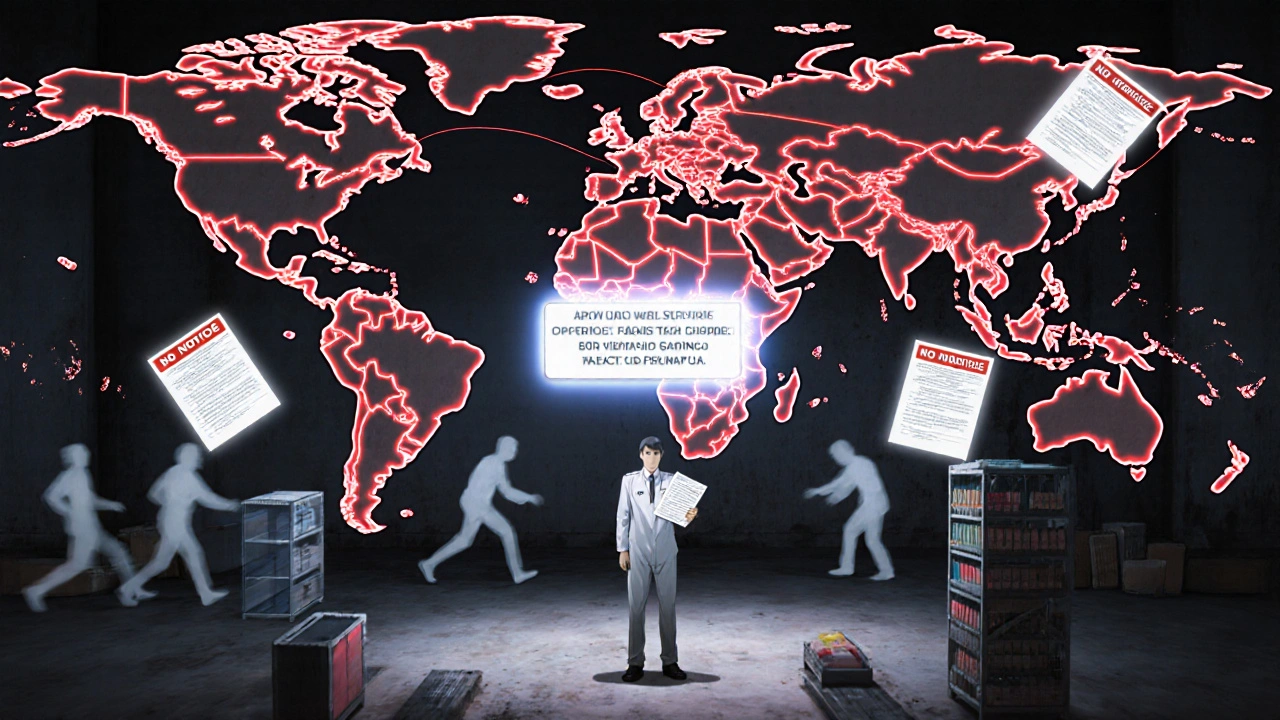The U.S. Food and Drug Administration doesn’t call ahead. No warning. No scheduled appointment. Just a knock on the door-and inspectors walking into a factory, warehouse, or lab with no notice. This isn’t a drill. It’s standard procedure. And since May 2025, this surprise tactic is now the norm for foreign manufacturing facilities too.
Why the FDA Shows Up Without Warning
Imagine you’re running a factory that makes pills, medical devices, or packaged food. You know an inspection is coming next month. What do you do? You clean up. You fix the broken equipment. You retrain staff. You make sure the paperwork looks perfect. You hide the problems-until the inspectors leave. That’s exactly what the FDA wants to stop. Unannounced inspections are designed to catch things as they really are-not as they’re staged for a visit. The goal isn’t to trip companies up. It’s to see if safety and quality are built into daily operations, not just added for show. When inspectors arrive without notice, they get a real snapshot: Are workers following procedures? Are records accurate? Are sterile areas truly clean? According to the FDA, when foreign facilities got advance notice, inspectors still found serious violations more than twice as often as at domestic sites. That’s not a coincidence. It’s a signal that advance warning lets bad practices hide.The Big Shift: Foreign Facilities Are Now Treated Like Domestic Ones
For years, there was a double standard. If you made medicine in Ohio, the FDA showed up unannounced. If you made the same medicine in India or China, you got a heads-up-sometimes weeks in advance. Why? So the company could arrange translators, gather documents, and make sure the right people were on-site. That changed on May 6, 2025. The FDA announced it was ending the practice. Now, every facility-no matter where it’s located-faces the same rule: no notice. This wasn’t just a policy tweak. It was a fundamental shift in how the FDA protects American consumers. About 40% of finished drugs and 80% of active ingredients used in U.S. medicines come from overseas. If you’re not inspecting those places the same way you inspect U.S. factories, you’re leaving the door open for unsafe products. The FDA says this move ensures foreign manufacturers are held to the same standards as domestic ones. No exceptions. No loopholes.What Happens During a Surprise Visit
When FDA inspectors arrive, they don’t walk in like tourists. They’re trained, authorized, and armed with legal authority. Here’s how it typically goes:- They identify themselves and show official credentials.
- They hand over Form FDA 482-the official Notice of Inspection-to the most responsible person on-site.
- They explain the scope: Are they checking the quality system? The manufacturing process? The lab records?
- They ask for access to everything: production logs, cleaning records, training files, complaint reports, equipment maintenance logs.

Why This Matters More Than Ever
The global supply chain for medicines and food is more tangled than ever. A single pill might have ingredients from three countries, packaging from two, and final assembly in another. If one link in that chain is weak, the whole thing risks failure. Before the May 2025 policy change, foreign inspections had a 90% failure rate when companies were warned in advance. Domestic inspections? Around 45%. That gap wasn’t about skill-it was about preparation time. With weeks to fix things, companies could paper over problems. Now, with unannounced visits, the FDA sees the truth. And they’re using it to act. In 2025, the agency increased the number of unannounced foreign inspections by 30% compared to the prior year. They’re targeting high-risk facilities-those with past violations, those producing high-volume or high-risk products, and those in countries with weaker oversight. The message is clear: If you want to sell products in the U.S., you must operate like you’re always being watched.What Manufacturers Need to Do Now
You can’t prepare for a surprise if you’re not ready every day. The companies that survive these inspections aren’t the ones who scramble when they hear the doorbell. They’re the ones who built compliance into their daily routine. Here’s what works:- Train everyone. Not just managers. The person cleaning the floor, the technician running the machine, the clerk filing records. Everyone needs to know the rules-and why they matter.
- Use digital systems. Paper records can be lost, altered, or delayed. Modern Quality Management Systems (QMS) track every step in real time. If an inspector asks for a batch record from three months ago, it’s instantly available-not buried in a drawer.
- Run mock inspections. Once a quarter, have someone play FDA inspector. No warning. Just show up with a clipboard and ask for documents. See where your team freezes. Fix those gaps before the real thing happens.
- Keep documentation real. The FDA isn’t looking for perfect records. They’re looking for honest ones. If you’re falsifying data, you’re not just risking a citation-you’re risking lives. And the FDA will find out.

The Unanswered Questions
The policy change is bold. But it’s not perfect. One big concern: What happens with foreign regulators? For years, the FDA worked with local health authorities in countries like India and China. They’d notify them ahead of time, sometimes even inviting them to join the inspection. That helped build trust and shared standards. Now, with unannounced visits, that coordination is unclear. Will the FDA still inform local agencies? Or will they show up cold, risking diplomatic friction? That’s still unanswered. Another issue: language. If an inspector walks into a factory in Vietnam and no one speaks English, how do they communicate? The FDA hasn’t said how they’ll handle this. Will they bring translators on every trip? Or will companies need to have bilingual staff ready at all times? These aren’t just logistical problems. They’re real risks to the inspection process. If communication breaks down, so does compliance.The Bottom Line
Unannounced inspections aren’t about punishment. They’re about protection. The FDA isn’t trying to shut down factories. They’re trying to make sure every pill, every bandage, every jar of baby food that ends up in a U.S. home is safe. And they’ve decided that the only way to know that for sure is to show up without warning. For manufacturers, this isn’t a hurdle-it’s a new standard. The companies that thrive won’t be the ones with the fanciest brochures or the most polished presentations. They’ll be the ones who treat every day like it’s inspection day. Because now, it is.Are FDA inspections always unannounced?
Most are, but not all. Domestic inspections are typically unannounced, except in specific programs like pre-certification for new facilities. For foreign facilities, the FDA used to give advance notice-but since May 2025, nearly all foreign inspections are now unannounced. The only exceptions are for inspections tied to specific regulatory programs where advance notice is legally required to ensure proper staffing or documentation is available.
What happens if a company refuses an FDA inspection?
Refusing entry or delaying an inspection is a serious violation. The FDA can issue an import alert, blocking all products from that facility from entering the U.S. They can also pursue civil or criminal penalties, including fines and jail time for individuals found to have obstructed the inspection. The agency has clear legal authority under the Federal Food, Drug, and Cosmetic Act to enter and inspect facilities without consent.
Do unannounced inspections only target foreign facilities?
No. Domestic facilities have always been subject to unannounced inspections. The May 2025 change extended this practice to foreign manufacturers, closing a long-standing gap in oversight. Before that, foreign facilities often received advance notice, while U.S. ones did not. Now, the same rules apply to both.
How often do FDA inspectors visit foreign facilities?
The FDA conducts about 3,000 inspections annually at foreign facilities across more than 90 countries. Since May 2025, the agency has increased the frequency of unannounced visits, particularly for high-risk manufacturers-those producing critical drugs, high-volume products, or those with past violations. There’s no fixed schedule; inspections are risk-based and can happen anytime.
What’s the difference between a Form 483 and a warning letter?
A Form 483 is a list of observations made during an inspection-things the inspector saw that don’t meet FDA standards. It’s not a final decision. A warning letter is the next step: a formal notice that the FDA considers the violations serious enough to require corrective action. If the company doesn’t respond adequately, the FDA can take further action, like seizing products or banning imports.

Melvina Zelee
November 23, 2025 AT 12:17Honestly, this is the kind of thing that makes me trust my meds a little more. I used to worry that pills made overseas were just... lucky to be safe. Now I know someone’s checking the actual floor, not the staged version. Feels like justice.
Also, love that they’re not playing favorites anymore. If it’s in my body, it should meet the same standard, no matter where it was made.
steve o'connor
November 23, 2025 AT 17:05As someone who’s worked in pharma QA in Dublin, I can tell you - the ‘advance notice’ culture was a joke. We’d spend weeks prepping like it was a TED Talk. The inspectors knew. Everyone knew. This change? Long overdue. Real compliance isn’t a performance.
ann smith
November 24, 2025 AT 02:19This gives me so much peace of mind. 😊 I used to read about contaminated baby food or fake insulin and feel helpless. Knowing the FDA is showing up unannounced - like a guardian angel with a clipboard - makes me feel safer. Thank you for sharing this. 💙
Julie Pulvino
November 25, 2025 AT 06:07My cousin works at a small med device factory in Manila. She said they used to get a heads-up like it was a birthday party. Now they just get a knock. No time to panic, no time to fake it. She says it’s stressful at first, but now the whole team just... does their job right every day. No more ‘inspection mode.’ Just normal mode. And honestly? That’s better for everyone.
Patrick Marsh
November 25, 2025 AT 22:20Refusing inspection = violation. Import alert = automatic. Criminal charges = possible. No ambiguity. Good.
Daniel Jean-Baptiste
November 26, 2025 AT 11:17Big shift but i wonder how the language barrier is handled in vietnam or bangladesh. if the inspector says 'show me the sterilization logs' and the floor tech only speaks bengali... does it count as obstruction if they don't understand? the fda needs a plan for this. not just power. communication matters too
james lucas
November 27, 2025 AT 17:06Man, I used to work in a lab that made supplements for a big brand - we had a whole ‘inspection week’ every quarter. We’d even buy new lab coats just for the day. The inspectors always knew we were hiding stuff. Now? We just keep it clean all the time. No more drama. No more stress. Honestly, it made us better. We started actually caring about the details, not just the paperwork. And yeah, our error rates dropped by half. The FDA didn’t break us - they fixed us. I’m kinda grateful.
Jessica Correa
November 27, 2025 AT 21:06My dad’s a retired FDA inspector and he told me the real test isn’t what you show them - it’s what you don’t know they’re looking for. Like that one time they found a batch of insulin with the wrong pH because someone didn’t log a maintenance call on the mixer. No one even remembered it happened. But the log was there. And they saw it. That’s why surprise visits work. You can’t fake your habits.
manish chaturvedi
November 29, 2025 AT 18:56As someone from India who works in pharma exports, I want to say this change is fair. For years, we were treated like suspects instead of partners. Now, we’re held to the same standard. It’s harder, yes. But it’s honest. We’ve upgraded our QMS, trained everyone daily, and stopped using paper logs. We’re not afraid anymore. We’re proud. Because now, when our medicine reaches America, we know it’s not just compliant - it’s trustworthy.